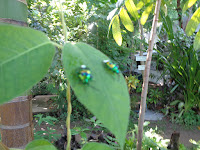Autotomy: Nature's Special Defense Mechanism
Dr Abe V Rotor
Philippine Sun Skink or Bubuli (Alibut Ilk) - Eutropis multifasciata). Skinks are lizards belonging to the family Scincidae with more than 1,500 species across 100 genera.
My cat caught a skink one lazy afternoon and brought it into our visitors room, apparently lifeless, while its tail vigorously wiggled not far from the tailless torso. I know as a biologist that certain lizards when faced with death automatically detach their tails, a mechanism given them by Nature as final and ultimate chance to escape and survive. The detached tail vigorously twitches to distract the predator in order to release the tailless creature which feigns dead to the attacker. With remaining strength the poor creature stealthily crawls and in a flash takes off to safety.
But my cat is stubborn, so I held him by the skin of his neck the way felines are carried when young and tightened my grip a little until it released its hold. The tailless skink had a bad wound. I helped it find a place in the garden with the hope that it would be able to recover. Meantime Its tail stopped twitching and my cat left the scene.
Fortunately the wounded skink survived. I glanced upon it in its hiding place a couple of months after, its tail stump had grown a new tail noticeably shorter at the moment than the lost one. House lizards (butiki) demonstrate the same phenomenon of survival that is specially rare in the animal kingdom.
The detached tail has a special color and glow as it continues to twitch,
attracting the predator to release its hold on the hapless prey.
Tail loss is also called "tail autotomy" or "caudal autotomy" or "tail-shedding." Many species of lizards like the skink and house lizard (butiki) are able to lose part of their tail to help them escape from predators. This phenomenon also applies to certain insects like grasshoppers, crickets and walking sticks. A grasshopper, when held by its hind leg, voluntarily discards that limb by intense muscular contraction and in the process ruptures it at the base of the femur. This case is also experienced when holding the pincers or claws of a crab. Before you know it the fellow has detached itself and gone back to the water. Nature nurtures the regrowth of these lost parts in due time, and soon the wounded creatures regain their normal appearances and activities.
Philippine Sun Skink or Bubuli (Alibut Ilk) - Eutropis multifasciata).
Acknowledgement: Lower photos from the Internet
Author's Note: The cat and skink encounter is typical and commonly taking place in the living world particularly in the wild. It is Nature's drama between a predator and prey. On the screen we watch a lion pursue a gazelle, pins it down while members of its pride wait, and soon partake in a raucous meal. A preying mantis catches a grasshopper with its spiked forelegs like a clamp writhing as it is devoured. A boa constrictor swallows a live rodent larger than its girth. Our Philippine eagle, in one blinding swoop, snatches a monkey in its perch, shreds it with its beak and claws and feeds its brood high up in its hidden abode. It is for this fact that our national bird is called monkey-eating eagle. It sounds primitive and brutal. Autotomy on the other hand, is finesse; it is Nature's art, a rare phenomenon in our living world. ~
































































